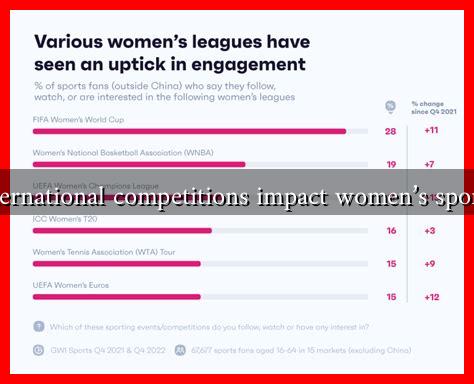-
Table of Contents
- How Do International Competitions Impact Women’s Sports Visibility?
- The Role of International Competitions in Promoting Women’s Sports
- Case Studies: Success Stories from International Competitions
- The Olympics
- FIFA Women’s World Cup
- The Impact of Social Media and Digital Platforms
- Challenges and Future Directions
- Conclusion
How Do International Competitions Impact Women’s Sports Visibility?
International competitions have long been a platform for showcasing athletic talent, but their impact on women’s sports visibility is particularly significant. As global events like the Olympics, FIFA Women’s World Cup, and various international championships gain traction, they play a crucial role in elevating the profile of women’s sports. This article explores how these competitions enhance visibility, promote gender equality, and inspire future generations of female athletes.
The Role of International Competitions in Promoting Women’s Sports
International competitions serve as a stage for female athletes to demonstrate their skills and achievements. The visibility gained from these events can lead to increased media coverage, sponsorship opportunities, and fan engagement. Here are some key ways in which international competitions impact women’s sports visibility:
- Media Coverage: Major international events often attract significant media attention, which can lead to increased coverage of women’s sports. For instance, the 2019 FIFA Women’s World Cup garnered over 1 billion viewers, highlighting the growing interest in women’s soccer.
- Sponsorship and Investment: As visibility increases, so does the potential for sponsorship deals. Companies are increasingly recognizing the value of associating with women’s sports, leading to more financial support for teams and athletes.
- Role Models: International competitions provide female athletes with a platform to become role models for young girls. Athletes like Serena Williams and Megan Rapinoe inspire the next generation to pursue sports, thereby increasing participation rates among women.
Case Studies: Success Stories from International Competitions
Several international competitions have significantly impacted women’s sports visibility. Here are a few notable examples:
The Olympics
The Olympic Games have been instrumental in promoting women’s sports since the inclusion of women’s events in 1900. The Tokyo 2020 Olympics, held in 2021, showcased female athletes in unprecedented numbers:
- Women made up 48.8% of the athletes, the highest percentage in Olympic history.
- Female athletes received extensive media coverage, with events like women’s soccer and gymnastics drawing significant viewership.
This increased visibility has led to greater recognition and support for women’s sports globally.
FIFA Women’s World Cup
The FIFA Women’s World Cup has also played a pivotal role in elevating women’s soccer. The 2019 tournament in France set new records:
- It attracted over 1.1 million spectators across stadiums.
- The final match between the USA and the Netherlands was watched by 14.3 million viewers in the United States alone.
This surge in interest has prompted FIFA to invest more in women’s soccer, leading to increased funding and development programs.
The Impact of Social Media and Digital Platforms
In addition to traditional media, social media and digital platforms have revolutionized how women’s sports are promoted. Athletes and teams can now connect directly with fans, share their stories, and build their brands. This has several implications:
- Direct Engagement: Athletes can engage with fans in real-time, fostering a sense of community and support.
- Increased Visibility: Social media platforms allow for the sharing of highlights, interviews, and behind-the-scenes content, increasing the visibility of women’s sports.
- Grassroots Movements: Campaigns like #SheBelieves and #LikeAGirl have gained traction on social media, promoting women’s sports and encouraging participation.
Challenges and Future Directions
Despite the progress made, challenges remain in achieving equal visibility for women’s sports. Issues such as unequal pay, limited media coverage, and societal stereotypes continue to hinder growth. However, the momentum generated by international competitions offers hope for the future:
- Continued advocacy for equal pay and resources.
- Increased investment from sponsors and media outlets.
- Ongoing support from organizations dedicated to promoting women’s sports.
Conclusion
International competitions play a vital role in enhancing the visibility of women’s sports. Through increased media coverage, sponsorship opportunities, and the emergence of role models, these events have the power to inspire and engage audiences worldwide. While challenges remain, the progress made thus far indicates a promising future for women’s sports. As we continue to support and promote female athletes, we pave the way for a more equitable and inclusive sporting landscape.
For more information on the impact of women’s sports, visit Women’s Sports Foundation.

